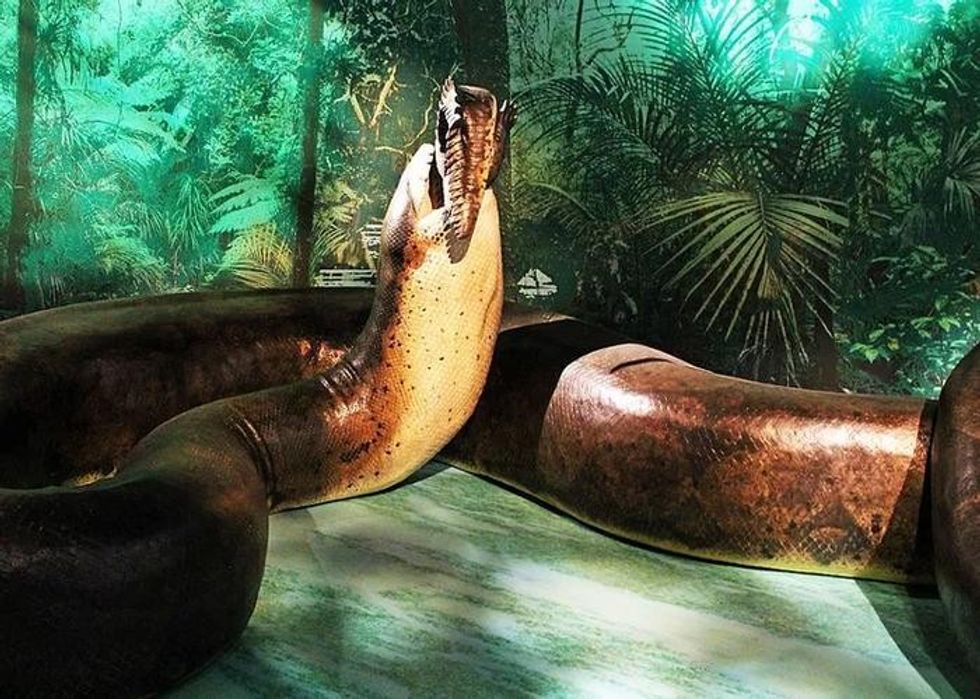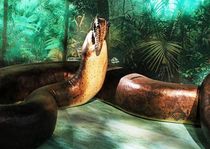The Titanoboa cerrejonensis was the largest snake in the world and belongs to the boa family. This cold-blooded snake went extinct about 60 million years ago due to climate change.
It was discovered in a coal mine of South America but is now placed at the Florida Museum of Natural history. Jonathan Bloch, a paleontologist at this museum said that the estimated Titanoboa size is about 43 ft (13.1 m).
Janson head, a paleontologist at the University of Toronto described the snake as a giant animal that has to squeeze itself from the door of its office if it wants to eat him. A life-sized model of Titanoboa cerrejonensis is displayed in the Smithsonian museum.
The size of this long snake has provided important cues about the environment of the earth at the time of its existence. For instance, the snake is an ectothermic reptile, which means it must be lived in an environment where the temperature was about 90° F (32° C).
This type of climate helped the animals of that time to attain a much bigger size than present-day snakes. There are many Titanoboa snake facts that you can learn about if you keep reading.
To know more about snakes, you may also check out these giant garter snake facts and python facts.
Titanoboa Interesting Facts
What type of animal is a Titanoboa?
Titanoboa was giant snake species that became extinct some million years ago. This giant snake is similar to the modern-day anaconda.
What class of animal does a Titanoboa belong to?
The Titanoboa was one of the largest snakes that belong to the class Reptilia of Phylum Chordata.
How many Titanoboas are there in the world?
As the Titanoboa is an extinct snake, there is no information available regarding the population size of this animal.
Where does a Titanoboa live?
Titanoboa was a 43 ft (13.1 m) snake that lived in La Guajira of South America. This snake used to live with big Crocodylomorpha and large turtles.
The paleogeography of the Paleocene epoch was a protected swamp area, shaded by the rising later La Guajira hills and the steadily emerging present-day Serranía del Perijá, with an open link to the proto-Caribbean.
In the climate of this habitat, the tropical aquatic ferns flourished, as revealed by fossils of these ferns in Cerrejón, the Palermo Formation, and the Bogotá Formation. The Titanoboa probably went extinct due to climate change which dropped temperatures on the earth.
What is a Titanoboa's habitat?
The fossils of plants that are found with the fossils of Titanoboa suggest the climate in which this snake lived was a tropical rainforest. Titanoboa was almost identical to the modern-day green anaconda that lives in the murky water of swamps, where it hides and waits for its prey to drink from the swamp.
Though, it also ate aquatic animals.
It seems that that the movement of Titanoboa was sluggish and it was not as quick on dry land, the same as the green anaconda. It was likely to hold its breath underwater for about an hour, which is an advantage for an aquatic trap hunter.
Who do Titanoboas live with?
It is believed that Titanoboa snakes must live alone like present-day green anacondas. However, it shared its habitat with snapping turtle carboneyms whose fossils were discovered from the same area where the remains of Titanoboa were found. It is not unbelievable that these giant reptiles mixed it up sometimes, by chance or during the hunt.
How long does a Titanoboa live?
Titanoboa, which was a boa constrictor-like snake, became extinct about 60 million years ago. Therefore, the lifespan of this large animal is unknown.
How do they reproduce?
Due to their extinction, there is not much information available regarding the reproduction of Titanoboa snakes. Like other modern reptiles, Titanoboa had breeding seasons.
Both male and female snakes used to live separately. During mating season, the female snake released a specific hormone to attract males.
Males of this species would fight with each other to mate with the female snake. The winning male impregnates the female. It is believed that sometimes just after the male fertilizes the eggs of a female snake, she would attack the male.
It was followed by a resting or gestation period, which was about seven months. After this period, Titanoboa snakes came out of a fine membrane on the sides of the body of their mother.
What is their conservation status?
Titanoboas were giant, boa-constrictor-like snakes, named Titanoboa cerrejonensis that went extinct nearly 60 million years ago. The main cause behind the disappearance and extinction must be climate change.
The dropping temperature of the earth favored the appearance of smaller snakes. With time, much larger reptiles were gradually erased, while other smaller reptiles took over their places on the planet. With the drop in temperature, the habitat change also contributed to the extinction of these titanic animals of the boa family.
In the Paleocene epoch, rainforests were reduced to grasslands. Therefore, due to lack of proper habitat they disappeared.
Titanoboa Fun Facts
What do Titanoboas look like?
Researchers compared the sizes and shapes of the fossilized vertebrae of the Titanoboa and estimated the total length to be 43 ft (13.1 m). Most fossils found are of adults, but some fossils of young are also found in the coal mine. These fossils consist of vertebrae and ribs.
Scientists estimated that there are 250 vertebrae in a Titanoboa. Only one fossil with a skull has been recovered. It turns out that this monster snake had significantly thick skin.
This cold-blooded snake also had excellent night vision. The color of the snake was dull brown to grayish and black. It lacked feet like other snakes.
How cute are they?
They are not cute animals. In fact, they are giant, dangerous, and resemble modern-day anaconda animals.
How do they communicate?
The information about how Titanoboas communicate is not available.
How big is a Titanoboa?
The Titanoboa, also known as titanic boa, is a giant snake that is 43 ft (13.1 m) long, which is about 100 times bigger than a royal python.
How fast can a Titanoboa move?
Despite its enormous size, Titanoboa swimming was it's preferred way to move in the waters. Also, on land, this titanic snake could move at a speed of 50 mph (80.4 kph). It made Titanoboa an arduous animal to outrun. Apart from these, it could also climb trees.
How much does a Titanoboa weigh?
The weight of a Titanoboa is 2,500 lb (1135 kg).
What are the male and female names of the species?
There are no specific names known for male and female Titanoboa snakes.
What would you call a baby Titanoboa?
The baby Titanoboa has no specific names.
What do they eat?
Scientists found fossils of crocodiles in the Cerrejón Formation alongside the Titanoboa. They also found large turtle fossils. These remains suggest that they are the food of Titanoboa.
Additionally, it can also eat large fish. It can dislocate its jaws to help swallow food, such as mammals larger than its own head. Some scientists assume that it can also eat other snakes.
Are they poisonous?
No, Titanoboa snakes are non-poisonous animals as they do not possess any poison-producing gland.
Would they make a good pet?
They are already extinct. Therefore, it is not possible to keep them as a pet.
Did you know...
The Titanoboa was the biggest snake on earth, dead or alive.
This giant monster was very much capable of swallowing a human, wholly.
There were no animals that could kill this giant monster due to their extreme size.
How did the Titanoboa go extinct?
Scientists believe that the Titanoboa probably went extinct due to climate change. In other words, climate degradation killed Titanoboa.
Titanoboa vs. other animals
After eating a large crocodile, it could go without eating anything for about one year.
Here at Kidadl, we have carefully created lots of interesting family-friendly animal facts for everyone to discover! For more relatable content, check out these milk snake facts and kukri snake facts pages.
You can even occupy yourself at home by coloring in one of our free printable Titanoboa coloring pages.










